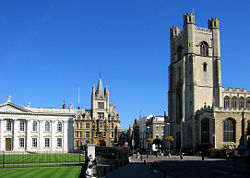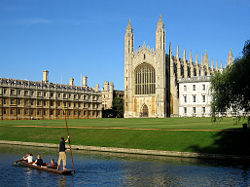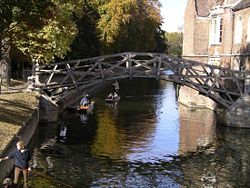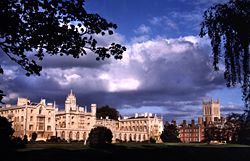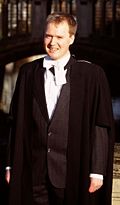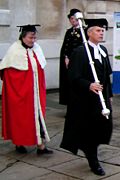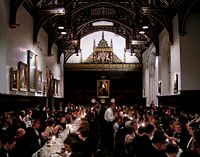Difference between revisions of "University of Cambridge" - New World Encyclopedia
m (→Academic Dress) |
|||
| Line 162: | Line 162: | ||
Formal Hall, or a formal dinner, involves dining in the collegiate manner served by servants, whilst wearing academic dress if at an academic college, and is typically lit by candles. It is normally preceded (and sometimes followed) by a Grace, which in older institutions may often be in Latin and is frequently peculiar to the institution in question. There may be one or more after dinner speakers at the end of the dinner or even between courses if it is a special occasion. [[Image:Cam formal dinner st johns hall 2005.jpg|right|thumb|200px|A formal dinner at [[St Johns College|St Johns College, Cambridge]].]] | Formal Hall, or a formal dinner, involves dining in the collegiate manner served by servants, whilst wearing academic dress if at an academic college, and is typically lit by candles. It is normally preceded (and sometimes followed) by a Grace, which in older institutions may often be in Latin and is frequently peculiar to the institution in question. There may be one or more after dinner speakers at the end of the dinner or even between courses if it is a special occasion. [[Image:Cam formal dinner st johns hall 2005.jpg|right|thumb|200px|A formal dinner at [[St Johns College|St Johns College, Cambridge]].]] | ||
| − | == | + | == Student Organizations == |
*Cambridge University Amateur Dramatic Club | *Cambridge University Amateur Dramatic Club | ||
| − | |||
*Cambridge Apostles | *Cambridge Apostles | ||
*Cambridge Student Liberal Democrats | *Cambridge Student Liberal Democrats | ||
Revision as of 15:01, 16 June 2006
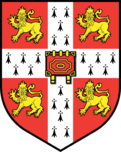 Latin: Universitas Cantabrigiensis | |
| Motto | Hinc lucem et pocula sacra Literal translation: “From here, light and sacred draughts”. Non-literal: “From the University, we receive enlightenment and precious knowledge”. |
|---|---|
| Established | 1209 |
| Type | Public |
| Location | Cambridge, Cambridgeshire, England, United Kingdom |
| Website | http://www.cam.ac.uk |
The University of Cambridge (or Cambridge University), located in Cambridge, England, is the second-oldest University in the English-speaking world. Early records indicate that the University grew out of an association of scholars within the city of Cambridge, and is believed to have been founded in 1209 by scholars escaping from the town of Oxford, England after a dispute with local townsmen.
The Universities of Cambridge and Oxford are jointly referred to by the portmanteau term Oxbridge. In addition to cultural and practical associations as a historic part of British society, the two Universities also maintain a long history of rivalry between one another.
Cambridge is a member of the Russell Group, a network of large, research-led British universities; the Coimbra Group, an association of leading European universities; the LERU (League of European Research Universities), and the IARU (International Alliance of Research Universities).
General Information
Cambridge is a collegiate university, with its main functions divided between the central departments of the university and a number of colleges. In general, the departments perform research and provide centralised lectures to students, while the colleges are responsible for the domestic arrangements and welfare of undergraduate students, graduate students, some of the postdocs and some University staff. The colleges also provide most of the small group teaching for undergraduates, referred to as supervisions. The thirty-one colleges are technically institutions independent of the university itself and enjoy considerable autonomy. For example, colleges decide which students they are to admit, and appoint their own fellows (senior members). (In Cambridge, “the university” often means the University as opposed to the Colleges.)
The current Chancellor of the university is Prince Philip, Duke of Edinburgh. The current Vice-Chancellor is Professor Alison Richard. The office of Chancellor, who holds office for life, is mainly symbolic, while the Vice-Chancellor (as is usual at British universities) is the real executive chief. The University is governed entirely by its own members, with no outside representation in its governing bodies. Ultimate authority lies with the Regent House, of which all current Cambridge academic staff are members, but most business is carried out by the Council. The Senate consists of all holders of the M.A. degree or higher degrees. It elects the Chancellor; until their abolition in 1950, it elected Members to the House of Commons for Cambridge University, but otherwise has not had a major role since 1926.
Reputation
According to UCAS, Cambridge and Oxford are the most academically selective universities in the United Kingdom - there is a special national admissions process which sets Oxbridge apart from other UK universities.
The university has often topped league tables ranking British universities - for instance, Cambridge was ranked first in the Sunday Times league table every year between 1997 and 2005. In the most recent UK government Research Assessment Exercise in 2001[1], Cambridge was ranked first in the country. In 2005, it was reported that Cambridge produces substantially more PhDs per year than any other UK university (over 30% more than second placed Oxford)[2]. In 2006, a Thomson Scientific study showed that Cambridge has the highest research paper output of any UK university, and is also the top research producer (as assessed by total paper citation count) in 10 out of 21 major UK research fields analyzed[3].
International league tables produced in 2005 by The Times Higher Education Supplement (THES) and Shanghai Jiao Tong University ranked Cambridge third 3 and second 4 in the world respectively. The THES also ranked Cambridge first in science, second in biomedicine, third in the arts & humanities, sixth in technology, and eighth in social sciences. Note that all university rankings are subject to controversy about their methodology, and that the THES and Jiao Tong tables are the only international rankings available.
Historically, the two universities have produced a significant proportion of Britain’s prominent scientists, writers and politicians. Affiliates of Cambridge University have won a total of 81 Nobel Prizes 1, more than any other university in the world 2. Seventy of these awardees also attended Cambridge as undergraduate or graduate students.
In addition to a long distinguished tradition in the humanities and the arts, the University of Cambridge is especially known for producing prominent scientists and mathematicians. This distinguished list includes Isaac Newton, Charles Darwin, William Harvey, Paul Dirac, J. J. Thomson, Ernest Rutherford, James Clerk Maxwell, Francis Crick, Alan Turing, Stephen Hawking, and Fred Sanger.
The university is also closely linked with the development of the high-tech business cluster in and around Cambridge, which forms the area known as Silicon Fen or sometimes the “Cambridge Phenomenon”. In 2004, it was reported that Silicon Fen was the second largest venture capital market in the world, after Silicon Valley. Estimates reported in February 2006 suggest that there were about 250 active startup companies directly linked with the university, worth around US$6 billion.
Endowment
Cambridge’s endowment (including the colleges) was estimated at £3.1 billion in late 2005[4] and is arguably the highest in Europe. Oxford (including its colleges) was possibly ranked second in 2005 with estimates ranging from £2.4bn to £2.9bn [5], and the Central European University in Budapest third with an estimated €400 million in 2005). The share of Cambridge’s endowment directly tied to the university itself exceeds £1 billion. However, Cambridge still relies largely on funding by the UK government. In comparison with US universities, the upper range of the endowment estimates places Cambridge at 6th or 7th (depending on whether one includes the University of Texas System - which incorporates 9 full scale universities and 6 health institutions[6]).
History
Roger of Wendover wrote that Cambridge University could trace its origins to a crime committed in 1209. Although not always a reliable source, the detail given in his contemporaneous writings lends them credence. Two Oxford scholars were convicted of the murder or manslaughter of a woman and were hanged by the town authorities with the assent of the King. In protest at the hanging, the University of Oxford went into voluntary suspension, and scholars migrated to a number of other locations, including the pre-existing school at Cambridge (Cambridge had been recorded as a “school” rather than University when John Grim held the office of Master there in 1201). These post-graduate researchers from Oxford started Cambridge’s life as a University in 1209. Cambridge’s status as a University is further confirmed by a decree in 1233 from Pope Gregory IX which awarded the ius non trahi extra (a form of legal protection) to the chancellor and universitas of scholars at Cambridge. After Cambridge was recognised by papal bull as a studium generale by Pope Nicholas IV in 1290, it became common for researchers from other European medieval universities to come and visit Cambridge to study or to give lecture courses.
The Colleges
Cambridge’s colleges were originally an incidental feature of the system. No college is as old as the university itself. The colleges were endowed fellowships of scholars. There were also institutions without endowments, called Hostels.
Hugh Balsham, Bishop of Ely, founded Peterhouse in 1284, Cambridge’s first college. Many colleges were founded during the fourteenth and fifteenth centuries, but colleges continued to be established throughout the centuries to modern times. The most recent college established is Robinson, built in the late 1970s. A list of the college is available by clicking the link above.
In medieval times, colleges were founded so that their students would pray for the souls of the founders. For that reason they were often associated with chapels or abbeys. A change in the colleges’ focus occurred in 1536 with the dissolution of the monasteries. King Henry VIII ordered the university to disband its Faculty of Canon Law and to stop teaching “scholastic philosophy”. In response, colleges changed their curricula away from canon law and towards the classics, the Bible, and mathematics.
Mathematics
From the time of Isaac Newton in the later 17th century until the mid-19th century, the university maintained a strong emphasis on mathematics. Study of this subject was compulsory for graduation, and students were required to take an exam for the Bachelor of Arts degree, the main first degree at Cambridge in both arts and science subjects. This exam is known as a Tripos. Students awarded first-class honours after completing the mathematics Tripos were named wranglers. The Cambridge Mathematical Tripos was competitive and helped produce some of the most famous names in British science, including James Clerk Maxwell, Lord Kelvin, and Lord Rayleigh. However, some famous students, such as G. H. Hardy, disliked the system, feeling that people were too interested in accumulating marks in exams and not interested in the subject itself.
Although diversified in its research and teaching interests, Cambridge today maintains its strength in mathematics. The Isaac Newton Institute, part of the university, is widely regarded as the UK’s national research institute for mathematics and theoretical physics. Cambridge alumni have won eight Fields Medals and one Abel Prize for mathematics. The University also runs a special Certificate of Advanced Studies in Mathematics course.
Women’s Education
Originally all students were male. The first colleges for women were Girton College (founded by Emily Davies) in 1869 and Newnham College in 1872. The first women students were examined in 1882 but attempts to make women full members of the university did not succeed until 1947. While Cambridge did not give degrees to women until this date, this fact is misleading. From the nineteenth century women were allowed to study courses, sit examinations, and have the result recorded. Other institutions treated this as a degree. In the twentieth century women could be given a “titular degree”. The difference was that without a full degree women were excluded from the governing of the university. This effectively denied woman a role in governance but not in recognized qualifications. Since students must belong to a college, and since established colleges remained closed to women, women found admissions restricted to colleges established only for women. All of the men’s colleges integrated genders between 1960 and 1988. One women’s college, Girton, also integrated genders, but the other women’s colleges took the view that until the gender ratio problem was completely solved, they should not reduce the number of women’s places available by admitting men to their colleges. In the academic year 2004-5, the university’s student gender ratio, including post-graduates, was male 52%: female 48% (Source: Cambridge University Reporter, [7]).
Research and Teaching
Cambridge University has research departments and teaching faculties in most academic disciplines. Cambridge tends to have a slight bias towards scientific subjects, but it also has a number of strong humanities and social science faculties. Academic staff (and often graduate students for the larger subjects) teach the undergraduates in both lectures and personal “supervisions” where a teacher-student ratio of between one-to-one and one-to-three is maintained. This pedagogical system is often cited as being unique to the Universities of Cambridge and Oxford (where “supervisions” are known as “tutorials”) — similar practices can be found elsewhere, though not on the Oxbridge scale.
All research and lectures are conducted by University Departments. The colleges are in charge of giving or arranging most supervision, student accommodations, and most extra-curricula activities. During the 1990s Cambridge added a substantial number of new specialist research laboratories on several University sites around the city, and major expansion continues on a number of sites[8].
Admission
Historically, undergraduate admission to Cambridge colleges depended on knowledge of Latin and Ancient Greek, subjects taught principally in the United Kingdom at fee-paying schools, called public schools. This resulted in a student body predominantly drawn from members of the British social elite.
The admission process changed in the 1960s. Successful applicants are expected to be predicted at least 3 A-grade A-level qualifications relevant to their chosen undergraduate course, or equivalent overseas qualifications. College Fellows also evaluate candidates on unexamined factors such as potential for original thinking and creativity as expressed in extra-curricular activities and at interview [9]. In a few cases, candidates may be offered an unconditional place.
In recent years, admissions tutors in certain subjects have required applicants to sit the more difficult STEP papers in addition to achieving top grades in their A-levels or International Baccalaureate diplomas. For example, Peterhouse requires 1 and 2 or better in STEP as well as A grades at A-levels including A-level Mathematics and Further Mathematics in order to be considered for entry for the Mathematical Tripos. Between one-half and two-thirds of those who apply with the correct grades are given offers of a place.
Public debate in the United Kingdom continues over whether admissions processes at Oxford and Cambridge are entirely merit based and fair, whether enough students from state schools are encouraged to apply to Cambridge, and whether these students succeed in gaining entry. Almost half of all successful applicants come from public schools. However, the average qualifications for successful applicants from state schools are poorer than the average qualification of successful applicants from private schools. The lack of state school applicants to Cambridge and Oxford has had a negative impact on Oxbridge’s reputation for many years, and the University has encouraged pupils from state schools to apply for Cambridge to help redress the imbalance. Critics counter that excessive government pressure to increase state school admissions constitute inappropriate social engineering [10] [11].
Graduate admission is first decided by the faculty or department relating to the applicant’s subject. This effectively guarantees admission to a college (probably but not necessarily the applicant’s preferred choice).
Athletics and Other Extracurricular Activities
Cambridge maintains a long tradition of student participation in sports and recreation. Rowing is a particularly popular sport at Cambridge, and there are competitions between colleges (notably the bumps races) and against Oxford (the Boat Race). There are also Varsity matches against Oxford in many other sports, ranging from rugby and cricket, to chess and tiddlywinks. Athletes representing the university in certain sports entitle them to apply for a Cambridge Blue at the discretion of the Blues Committee, consisting of the captains of the thirteen most prestigious sports. There are also the self-described “unashamedly elite” Hawks’ Club, whose membership is usually restricted to Cambridge Full Blues and Half Blues.
The Cambridge Union serves as a focus for debating. Drama societies notably include the Amateur Dramatic Club (ADC) and the comedy club Footlights, which are known for producing well-known showbusiness personalities. Student newspapers include the long-established Varsity and its younger rival, The Cambridge Student. The student-run radio station, CUR1350, promotes broadcast journalism.
Myths, Legends and Traditions
There are a number of popular myths associated with Cambridge University and its history.
One famous myth relates to Queens’ College’s so-called Mathematical Bridge (pictured right). Supposedly constructed by Sir Isaac Newton, it reportedly held itself together without any bolts or screws. Legend has it inquisitive students took it apart and were then unable to reassemble it without bolts. However, the bridge was erected 22 years after Newton’s death. This myth may have arisen from the fact that earlier versions of the bridge used iron pins and screws at the joints, whereas the current bridge uses more visible nuts and bolts.
Another famous myth involves the Clare Bridge of Clare College. Spherical stone ornaments adorn this bridge. One of these has a quarter sphere wedge removed from the back. This is a feature pointed out on almost all tours over the bridge. Legend has it that the bridge’s builder was not paid in full due to the college’s dissatisfaction with its construction. The builder thus took revenge and committed a small act of petty vandalism. Though lacking evidence, this legend is commonly accepted.
A discontinued tradition is that of the wooden spoon, the ‘prize’ awarded to the student with the lowest passing grade in the final examinations of the Mathematical Tripos. The last of these spoons was awarded in 1909 to Cuthbert Lempriere Holthouse, an oarsman of the Lady Margaret Boat Club of St John’s College. It was over one metre in length and had an oar blade for a handle. Since 1909, results were published alphabetically within class rather than score order. This made it harder to ascertain who the winner of the spoon was (unless there was only one person in the third class), and so the practice was abandoned.
On the other hand, the legend of the Austin Seven delivery van that ended up on the apex of the Senate House is no myth at all. The Caius College website recounts in detail how this vehicle “went up in the world”. [12]
Miscellaneous
Building on its reputation for enterprise, science and technology, Cambridge has a partnership with MIT in the United States, the Cambridge-MIT Institute.
In 2000, Bill Gates of Microsoft donated US$210 million through the Bill and Melinda Gates Foundation to endow the Gates Scholarships for students from outside the UK seeking postgraduate study at Cambridge. The University of Cambridge Computer Laboratory, which taught the world’s first computing course in 1953, is housed in a building partly funded by Gates and named after his grandfather, William Gates.
After the founding in 1636 of the first institute of higher education in the Americas, Harvard College in Newtowne, Massachusetts, the town adopted the new name of “Cambridge” in 1638 to promote its reputation as an academic centre. The first president (Henry Dunster), the first benefactor (John Harvard), and the first schoolmaster (Nathaniel Eaton) of Harvard were all Cambridge University alumni, as was the then ruling (and first) governor of the Massachusetts Bay Colony, John Winthrop. In 1629, Winthrop had led the signing of the founding document of the city of Boston which was known as the Cambridge Agreement, after the university [13].
In the Meiji Era (1868-1912), several Japanese students studied at the university.[14].
In Japan, there is a Cambridge and Oxford Society[15], a rare example of the name Cambridge coming before Oxford when the two universities are referred to together — traditionally, the order used when referring to both universities is “Oxford and Cambridge”, the order in which they were founded. The probable reason for this inversion is that the Cambridge Club was founded first in Japan, and it also had more members than its Oxford counterpart when they amalgamated in 1905.
The University’s publishing arm, the Cambridge University Press, is the oldest printer and publisher in the world.
Each Christmas Eve, BBC television and radio broadcasts The Festival of Nine Lessons and Carols by the Choir of King’s College Chapel. This has been a national Christmas tradition since it was first transmitted in 1928.
University Colleges
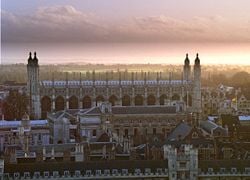
The University of Cambridge currently has 31 colleges, three of which, New Hall, Newnham College and Lucy Cavendish College, admit only women. The remaining 28 are coed, with Magdalene College being the last all-male college to admit women in 1988. Two colleges, Clare Hall and Darwin College, admit only postgraduates, while the following four admit mainly graduate students: Hughes Hall, Lucy Cavendish College, St. Edmund's College, and Wolfson College. The other 25 colleges admit primarily undergraduate students, though allow for the admittance of some postgraduate students pursuing certain courses of study or research. Although some colleges emphasize the pursuit of a particular subject, such as Churchill College which has a formalized bias towards the sciences and engineering, the majority of Cambridge’s colleges admit students studying a broad array of subjects. It is noteworthy that costs to students (mainly room and board) vary considerably from college to college. This may be of increasing significance to potential applicants as Government grants have proven to decline annually.
There are several historical colleges which no longer exist, such as King's Hall (founded in 1317) and Michaelhouse which were combined together by Henry VIII of England to establish Trinity College, Cambridge's largest College, in 1546. Additionally Gonville Hall, originally founded in 1348, was again re-founded in 1557 as Cambridge's Gonville and Caius College.
There are also several theological colleges in Cambridge, such as Westminster College and Ridley Hall, that are loosely affiliated with the university through the Cambridge Theological Federation.
Academic Dress
The University of Cambridge has a long tradition of academic dress worn most often on formal occasions. In their first week at Cambridge, many undergraduates will seek to buy or borrow a formal gown when officially enrolling, or matriculating, at the University. Those enrolled at the more traditional colleges most often choose to purchase a gown as the number of occasions on which it is worn quickly repays the investment. Gowns are often ‘recycled’ between generations, as graduate students seek to upgrade their gowns at the start of the academic year.
Gowns are most often worn to Chapel and to Formal Hall, a formal dinner held nightly in some colleges, or once a term in others. Various College events also demand academic dress. For example, the Trinity College statute prefers students to wear academic dress when appearing before senior members, or faculty, on particular occasions; such as appearing before a disciplinary committee. Gowns are also worn, with a hood, to graduation ceremonies, though there exist rules regarding which type of gown or hood a graduating student should wear. However, the general extent to which formal dress applies varies greatly according to college, as some colleges dispense with it even for Formal Hall.
When wearing academic dress, a person wears both the gown and the hood of the highest degree he or she has already received from the University of Cambridge. Anyone who does not hold a Cambridge degree, such as an undergraduate student or graduate student of another university, wears a gown according to his or her status in Cambridge. In addition, he or she wears the hood of the highest degree of which he or she is to receive. The gowns used by Cambridge are divided into four groups: the undergraduate gown, the Bachelor of Arts (B.A.) gown, the Master of Arts (M.A.) gown and the doctoral gown. Hoods are worn on the back of the open-fronted gowns as an indicator of academic status and vary by color according to degree. A form of black cap known as a mortarboard, or square, may be worn or carried and are often a part of required dress for graduates.
Student Dress
All undergraduate gowns resemble knee-length versions of the B.A. gown, but many colleges at Cambridge have gowns that differ slightly from the main pattern. The standard gown is black, and most colleges' gowns include minor variations such as sleeve decoration. The most distinct differences are the blue color of the undergraduate gowns of Trinity and Caius and the blue facings of Selwyn.
The two most common graduate gowns in Cambridge are the B.A. gown and the M.A. gown. Like the University of Oxford, all undergraduates at Cambridge traditionally graduate with a Bachelor of Arts degree after three years, though graduates can obtain a master's degree after a further year of study and graduate with both degrees at once.
Official Dress
The Chancellor
On ceremonial occasions, the Chancellor of the University wears a black silk gown with train, decorated by a gold lace. This gown is similar to that of the Lord Chancellor's.
The Vice-Chancellor
The Vice-Chancellor, when conferring degrees, wears a scarlet cope trimmed with white fur, as shown in the image.
Proctors
The Proctors of Cambridge University are formally responsible for the discipline of junior members of the University. In addition, they have various ceremonial and administrative roles, which they are, in practice, mainly occupied with.
Historically, University Proctors could be seen patrolling the campus after dark with the university police, or bulldogs. These traditions have since ceased, though the Proctors are still responsible for disciplinary actions thoughout the Colleges. On ceremonial occasions, Proctors wear the academic dress of a Master of Arts adorned with a distinctive 'ruff' at the neckline, while Proctor Constables wear top hats and cloaks.
Other officials
Other officials, such as the Esquire Bedell or Orator, wear the academic dress appropriate to their degree during ceremonial occasions.
Formal Hall
Formal Hall, or a formal dinner, involves dining in the collegiate manner served by servants, whilst wearing academic dress if at an academic college, and is typically lit by candles. It is normally preceded (and sometimes followed) by a Grace, which in older institutions may often be in Latin and is frequently peculiar to the institution in question. There may be one or more after dinner speakers at the end of the dinner or even between courses if it is a special occasion.
Student Organizations
- Cambridge University Amateur Dramatic Club
- Cambridge Apostles
- Cambridge Student Liberal Democrats
- The Cambridge Union Society
- Cambridge University Association Football League
- Cambridge University Conservative Association
- Cambridge University Cricket Club
- Cambridge University Labour Club
- Cambridge University Rugby Union Football Club
- Cambridge University Student Alliances
- Cambridge University Student Radio Station CUR1350
- The Varsity Newspaper
- The Cambridge Student Newspaper
Selected Notable Members
|
|
Organizations and Institutions Associated with the University
- Alumni website
- Babraham Institute
- Cambridge Assessment
- Cambridge Network
- Cambridge Science Park
- Cambridge Stem Cell Initiative
- Cambridge University Library
- Cambridge University Press
- Cambridge University Students’ Union
- Franco-British Student Alliance
- Graduate Union of Cambridge University
- Gurdon Institute of Cancer and Developmental Biology
- Isaac Newton Institute for Mathematical Sciences
- League of European Research Universities
- The Naked Scientists
- New Museums Site
- Phoenix
- West Cambridge
- Westminster Quarters
Cambridge Literature
- A Concise History of the University of Cambridge, by Elisabeth Leedham-Green, Cambridge University Press, 1996, ISBN 0521439787, ISBN 9780521439787.
- Teaching and Learning in 19th century Cambridge, by J. Smith and C. Stray (editors), Boydell Press, 2001 ISBN 0851157831.
- The Architectural History of the University of Cambridge and of the Colleges of Cambridge and Eton, by Robert Willis, Edited by John Willis Clark. Three volume set, Cambridge University Press, 1988 ISBN 0521358515.
- The Cambridge Apostles: A History of Cambridge University’s Elite Intellectual Secret Society, by Richard Deacon, Cassell, 1985 ISBN 0947728139.
ReferencesISBN links support NWE through referral fees
- Note 1: [16] - The list of Cambridge’s 81 Nobel Prize winners, from the University of Cambridge website.
- Note 2: [17] - A list of universities with the most Nobel Prize winner affiliations. The University of Chicago has the second most with 78 (30 of which were won by former students).
- Note 3: [18] - A 2005 ranking from The Times Higher Education Supplement of the world’s research universities, with Cambridge ranked 3rd, behind Harvard and MIT.
- Note 4: [19] - A 2005 ranking from the Institute of Higher Education, Shanghai Jiao Tong University of the world’s research universities, with Cambridge ranked 2nd, behind Harvard.
External links
- University of Cambridge official website
- A Short History of the University – from the official website
- Cambridge expansion plans
- talks.cam.ac.uk – Cambridge University talks-listing service
- Varsity – a student newspaper
- The Cambridge Student (TCS) – a student newspaper
- BlueSci – student science magazine
- Cambridge Alumni Magazine
- Gown – the graduate magazine
- CUR1350 – the student-run radio station
- Tompkins Table - unofficial ranking of Cambridge colleges
- Cambridge University jargon
- Cambridge Online – a comprehensive city guide and directory with thousands of pages of local information contributed by Cambridge residents
- Computing-Info - Information for prospective students about computing and networking policies at the University and within the colleges
Credits
New World Encyclopedia writers and editors rewrote and completed the Wikipedia article in accordance with New World Encyclopedia standards. This article abides by terms of the Creative Commons CC-by-sa 3.0 License (CC-by-sa), which may be used and disseminated with proper attribution. Credit is due under the terms of this license that can reference both the New World Encyclopedia contributors and the selfless volunteer contributors of the Wikimedia Foundation. To cite this article click here for a list of acceptable citing formats.The history of earlier contributions by wikipedians is accessible to researchers here:
- University_of_Cambridge history
- Formal_dinner history
- Academic_dress_of_the_University_of_Cambridge history
The history of this article since it was imported to New World Encyclopedia:
Note: Some restrictions may apply to use of individual images which are separately licensed.
